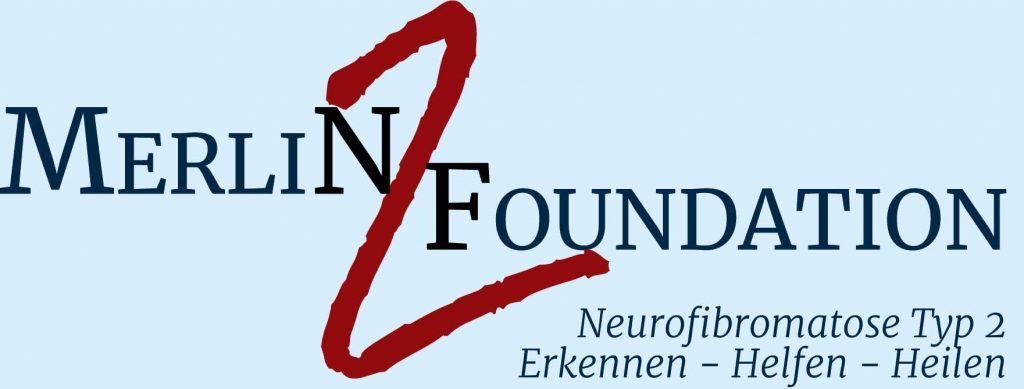Why Merlin?
MERLIN is not only the name of the famous wizard, but it is also the abbreviation for an important protein molecule in the human body. The molecule functions as a tumour suppressor; If the gene that codes for MERLIN is missing or dysfunctional, tumours continue to develop causing the disease NF2.
What is neurofibromatosis type 2?
Neurofibromatosis type 2 (NF2 for short) is a rare, genetic disease that, among other things, causes the emergence and growth of tumours in the entire nervous system. In many cases, these benign tumours keep appearing throughout a lifetime leading to a loss of nerve functions. How many tumours develop and when, how quickly they grow and how dangerous they are depending on their location varies from case to case.
Since it is a genetic defect, one cannot speak of a “beginning” of the disease, it is innate. NF2 affects approximately 1 in 33,000 newborns. In half of those affected the disease is inherited from one parent. In the other half it appears as a new genetic mutation.
Most people with NF2 show their first symptoms during puberty or their twenties; few develop symptoms in childhood, and some do not have any until they are 40 or 50 years old. Even within a family, the course of the disease can be very different. However, the auditory nerves are almost always affected, causing most patients to lose their hearing and develop problems with their sense of balance.
Currently, there is no cure for the genetic defect. Some of the current treatment options are not without risk. The course of the disease varies greatly from person to person, so the treatment must be adapted individually.
Source: nf2.de
Living with neurofibromatosis type 2
NF2 is a very serious disease. It is important that the person affected, his/her relatives and also the family doctor look into the disease. A person with NF2 needs to observe himself closely as well as being accurately monitored. Only rarely it is possible to repair neurological damage that has already occurred.
Initial symptoms of NF2 are often decreased or complete hearing loss, ringing, hissing, and whistling in the ears (tinnitus) and/or problems with balance. Persistent headache and dizziness may occur with these symptoms. Small skin tumours (neurofibromas) can also be a first sign. Neurological deficits caused by tumours on the spine rarely appear as the first sign of NF2. People often have unclear symptoms for many years before the actual underlying disease is diagnosed. Since in the case of NF2, the tumours of which most are benign grow slowly, it is likely that they will have grown for many years before they start causing symptoms.
As soon as NF2 sufferers are confronted with their threatened deafness, mental processing begins. Many try to imagine what it will be like to hear nothing anymore and to cope with it. Today, there is a chance to preserve a patient’s hearing during operation. Nevertheless, not knowing what might come makes life planning much more challenging and often plunges those affected into a period of difficult uncertainty. At the same time a period of grief sets in which you should acknowledge in order to prepare for the coming loss.
With increasing hearing loss comes the fear of things getting worse or sudden hearing loss. For the severely hard of hearing and deaf people typical problems begin. Often you no longer understand what is being said, feel left out, as if behind a plate-glass window. Especially at the beginning you suddenly seem completely helpless and dependent on the goodwill of your loved ones. You no longer feel like an independent subject, but as a dependent object. The frequent misunderstandings and small failures everyday lead to a lack of self-confidence. This can go so far that those affected withdraw into resignation and become stubborn. For these reasons, many of those affected also regularly seek psychotherapeutic help.
An insight into life with NF2 has been described in a book trilogy created by the German Nf2 community. The second and third part also feature stories of several indirectly affected such as doctors, therapists, family members and partners. 100% of the proceeds from book sales go to the Merlin Foundation. The books can be ordered here: www.frdrk.net
Source: nf2.de
Further scientific articles on NF2
The article “The Neurofibromatoses” was published in the Deutsches Ärzteblatt in 2020. It is an ideal introduction and describes the clinical picture, diagnosis, and current treatment options for neurofibromatoses. It is freely available athttps://pubmed.ncbi.nlm.nih.gov/32657748/.
A number of publications from the research group in Erfurt have dealt with the growth behaviour of tumours in neurofibromatosis type 2. It was particularly interesting that most tumours do not grow at the same rate, but have erratic growth phases that alternate with phases of relative size constancy:
- Brain tumours: https://pubmed.ncbi.nlm.nih.gov/27777160/
- Spinal tumours: https://pubmed.ncbi.nlm.nih.gov/27208873/
- Gender-specific differences: https://pubmed.ncbi.nlm.nih.gov/27590907/
The summaries can be read free of charge, but the articles themselves are subject to a charge.
A meta-analysis from 2019 summarizes all clinical articles published up to March 2019 on the subject of bevacizumab (also known under the brand name Avastin) in neurofibromatosis type 2 and describes its positive effect on hearing preservation and reducing the growth rate of vestibular schwannomas (tumours of the auditory nerves). The summary is available at https://pubmed.ncbi.nlm.nih.gov/31254266/.
In 2016, an interesting study on quality of life in neurofibromatosis type 2 was published. The authors found that patients with neurofibromatosis type 2 reported a reduced quality of life overall, and that large vestibular schwannomas apparently had a negative impact on quality of life, but operations did not.https://pubmed.ncbi.nlm.nih.gov/27050651/
